Victimology Project: Drunk Driving, Victimization, and Law
VerifiedAdded on 2023/04/21
|5
|1114
|124
Project
AI Summary
This victimology project analyzes a case study involving a drunk driver, John Mathews, who caused an accident resulting in severe injuries to an elderly couple. The project explores the appropriate criminal justice sentence for John, considering the victims' rights and his history of drunk driving. It investigates recidivism rates for drunk driving, examines the effectiveness of current laws, and proposes potential modifications. Furthermore, the project assesses the financial and psychological impacts on the victims' families and identifies the ideal victimologist for John Mathews, emphasizing the importance of empathy and understanding in providing therapeutic assistance. The project draws on research and legal principles to provide a comprehensive analysis of the case and its implications.
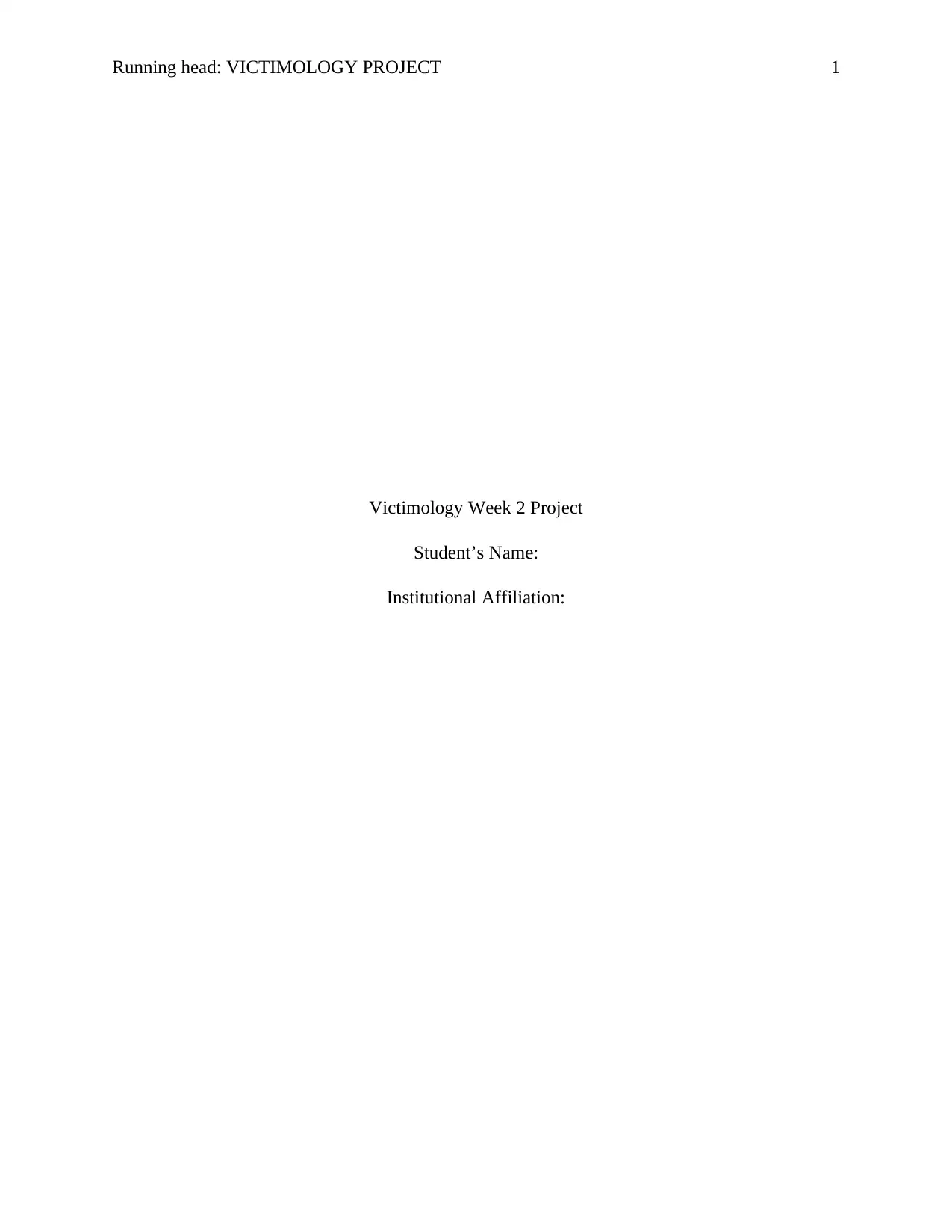
Running head: VICTIMOLOGY PROJECT 1
Victimology Week 2 Project
Student’s Name:
Institutional Affiliation:
Victimology Week 2 Project
Student’s Name:
Institutional Affiliation:
Secure Best Marks with AI Grader
Need help grading? Try our AI Grader for instant feedback on your assignments.
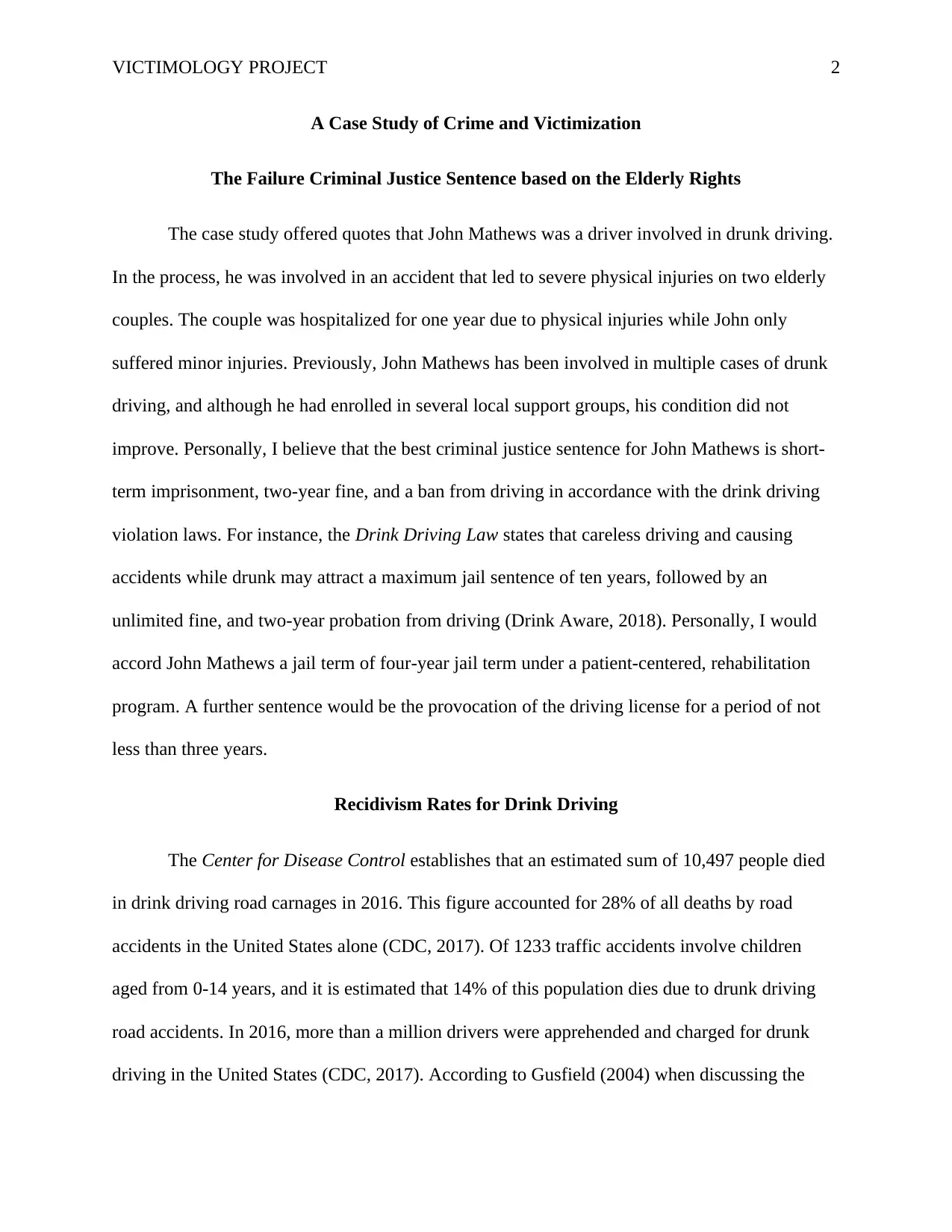
VICTIMOLOGY PROJECT 2
A Case Study of Crime and Victimization
The Failure Criminal Justice Sentence based on the Elderly Rights
The case study offered quotes that John Mathews was a driver involved in drunk driving.
In the process, he was involved in an accident that led to severe physical injuries on two elderly
couples. The couple was hospitalized for one year due to physical injuries while John only
suffered minor injuries. Previously, John Mathews has been involved in multiple cases of drunk
driving, and although he had enrolled in several local support groups, his condition did not
improve. Personally, I believe that the best criminal justice sentence for John Mathews is short-
term imprisonment, two-year fine, and a ban from driving in accordance with the drink driving
violation laws. For instance, the Drink Driving Law states that careless driving and causing
accidents while drunk may attract a maximum jail sentence of ten years, followed by an
unlimited fine, and two-year probation from driving (Drink Aware, 2018). Personally, I would
accord John Mathews a jail term of four-year jail term under a patient-centered, rehabilitation
program. A further sentence would be the provocation of the driving license for a period of not
less than three years.
Recidivism Rates for Drink Driving
The Center for Disease Control establishes that an estimated sum of 10,497 people died
in drink driving road carnages in 2016. This figure accounted for 28% of all deaths by road
accidents in the United States alone (CDC, 2017). Of 1233 traffic accidents involve children
aged from 0-14 years, and it is estimated that 14% of this population dies due to drunk driving
road accidents. In 2016, more than a million drivers were apprehended and charged for drunk
driving in the United States (CDC, 2017). According to Gusfield (2004) when discussing the
A Case Study of Crime and Victimization
The Failure Criminal Justice Sentence based on the Elderly Rights
The case study offered quotes that John Mathews was a driver involved in drunk driving.
In the process, he was involved in an accident that led to severe physical injuries on two elderly
couples. The couple was hospitalized for one year due to physical injuries while John only
suffered minor injuries. Previously, John Mathews has been involved in multiple cases of drunk
driving, and although he had enrolled in several local support groups, his condition did not
improve. Personally, I believe that the best criminal justice sentence for John Mathews is short-
term imprisonment, two-year fine, and a ban from driving in accordance with the drink driving
violation laws. For instance, the Drink Driving Law states that careless driving and causing
accidents while drunk may attract a maximum jail sentence of ten years, followed by an
unlimited fine, and two-year probation from driving (Drink Aware, 2018). Personally, I would
accord John Mathews a jail term of four-year jail term under a patient-centered, rehabilitation
program. A further sentence would be the provocation of the driving license for a period of not
less than three years.
Recidivism Rates for Drink Driving
The Center for Disease Control establishes that an estimated sum of 10,497 people died
in drink driving road carnages in 2016. This figure accounted for 28% of all deaths by road
accidents in the United States alone (CDC, 2017). Of 1233 traffic accidents involve children
aged from 0-14 years, and it is estimated that 14% of this population dies due to drunk driving
road accidents. In 2016, more than a million drivers were apprehended and charged for drunk
driving in the United States (CDC, 2017). According to Gusfield (2004) when discussing the
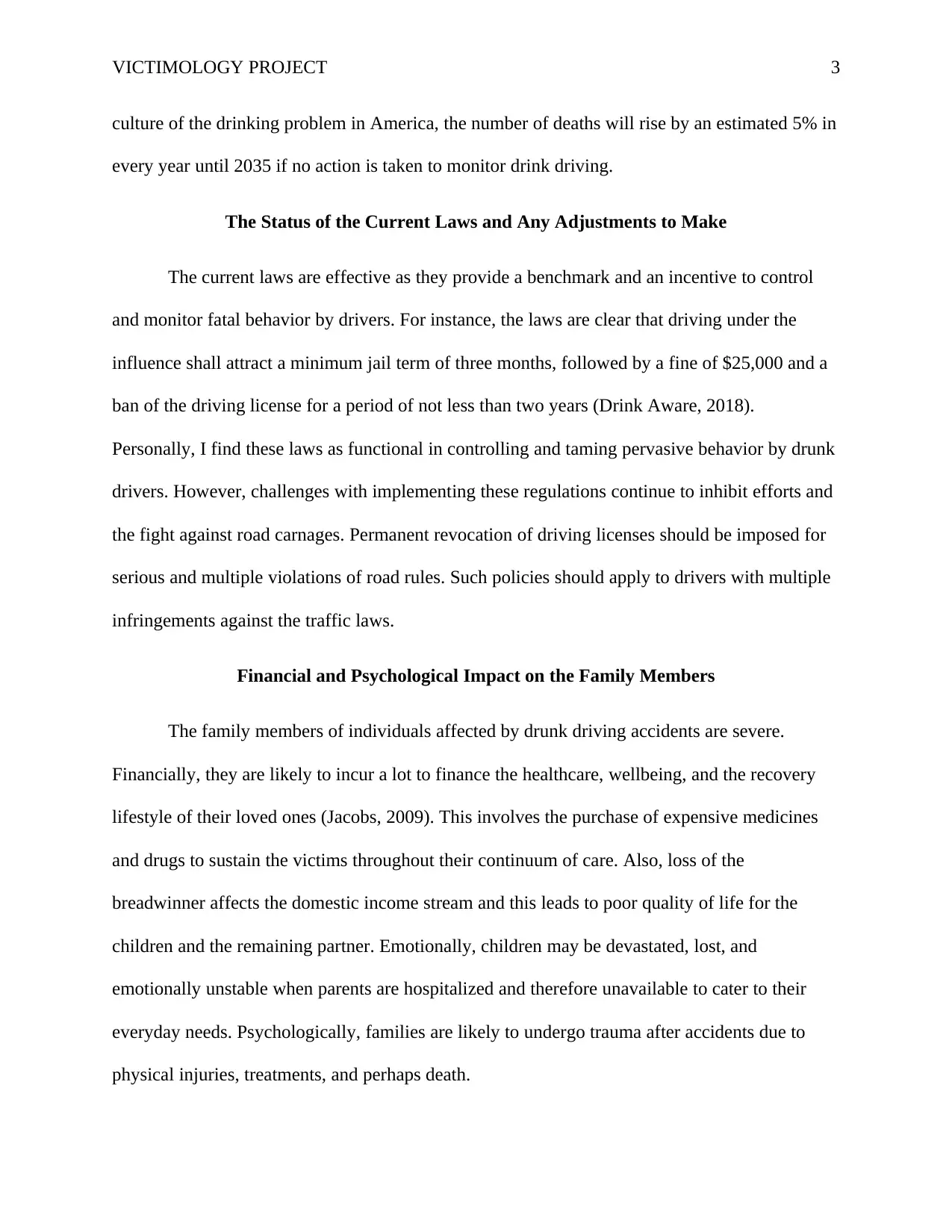
VICTIMOLOGY PROJECT 3
culture of the drinking problem in America, the number of deaths will rise by an estimated 5% in
every year until 2035 if no action is taken to monitor drink driving.
The Status of the Current Laws and Any Adjustments to Make
The current laws are effective as they provide a benchmark and an incentive to control
and monitor fatal behavior by drivers. For instance, the laws are clear that driving under the
influence shall attract a minimum jail term of three months, followed by a fine of $25,000 and a
ban of the driving license for a period of not less than two years (Drink Aware, 2018).
Personally, I find these laws as functional in controlling and taming pervasive behavior by drunk
drivers. However, challenges with implementing these regulations continue to inhibit efforts and
the fight against road carnages. Permanent revocation of driving licenses should be imposed for
serious and multiple violations of road rules. Such policies should apply to drivers with multiple
infringements against the traffic laws.
Financial and Psychological Impact on the Family Members
The family members of individuals affected by drunk driving accidents are severe.
Financially, they are likely to incur a lot to finance the healthcare, wellbeing, and the recovery
lifestyle of their loved ones (Jacobs, 2009). This involves the purchase of expensive medicines
and drugs to sustain the victims throughout their continuum of care. Also, loss of the
breadwinner affects the domestic income stream and this leads to poor quality of life for the
children and the remaining partner. Emotionally, children may be devastated, lost, and
emotionally unstable when parents are hospitalized and therefore unavailable to cater to their
everyday needs. Psychologically, families are likely to undergo trauma after accidents due to
physical injuries, treatments, and perhaps death.
culture of the drinking problem in America, the number of deaths will rise by an estimated 5% in
every year until 2035 if no action is taken to monitor drink driving.
The Status of the Current Laws and Any Adjustments to Make
The current laws are effective as they provide a benchmark and an incentive to control
and monitor fatal behavior by drivers. For instance, the laws are clear that driving under the
influence shall attract a minimum jail term of three months, followed by a fine of $25,000 and a
ban of the driving license for a period of not less than two years (Drink Aware, 2018).
Personally, I find these laws as functional in controlling and taming pervasive behavior by drunk
drivers. However, challenges with implementing these regulations continue to inhibit efforts and
the fight against road carnages. Permanent revocation of driving licenses should be imposed for
serious and multiple violations of road rules. Such policies should apply to drivers with multiple
infringements against the traffic laws.
Financial and Psychological Impact on the Family Members
The family members of individuals affected by drunk driving accidents are severe.
Financially, they are likely to incur a lot to finance the healthcare, wellbeing, and the recovery
lifestyle of their loved ones (Jacobs, 2009). This involves the purchase of expensive medicines
and drugs to sustain the victims throughout their continuum of care. Also, loss of the
breadwinner affects the domestic income stream and this leads to poor quality of life for the
children and the remaining partner. Emotionally, children may be devastated, lost, and
emotionally unstable when parents are hospitalized and therefore unavailable to cater to their
everyday needs. Psychologically, families are likely to undergo trauma after accidents due to
physical injuries, treatments, and perhaps death.
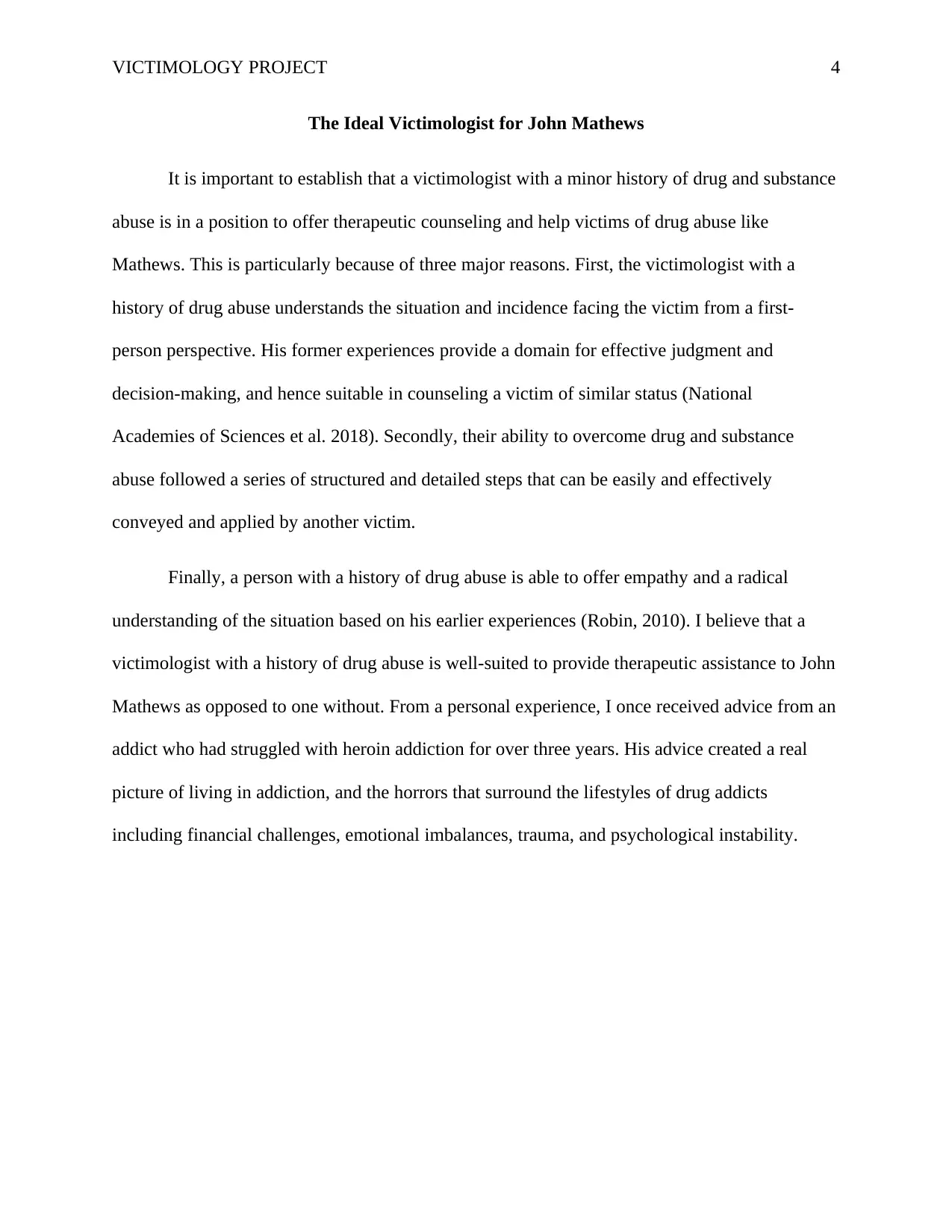
VICTIMOLOGY PROJECT 4
The Ideal Victimologist for John Mathews
It is important to establish that a victimologist with a minor history of drug and substance
abuse is in a position to offer therapeutic counseling and help victims of drug abuse like
Mathews. This is particularly because of three major reasons. First, the victimologist with a
history of drug abuse understands the situation and incidence facing the victim from a first-
person perspective. His former experiences provide a domain for effective judgment and
decision-making, and hence suitable in counseling a victim of similar status (National
Academies of Sciences et al. 2018). Secondly, their ability to overcome drug and substance
abuse followed a series of structured and detailed steps that can be easily and effectively
conveyed and applied by another victim.
Finally, a person with a history of drug abuse is able to offer empathy and a radical
understanding of the situation based on his earlier experiences (Robin, 2010). I believe that a
victimologist with a history of drug abuse is well-suited to provide therapeutic assistance to John
Mathews as opposed to one without. From a personal experience, I once received advice from an
addict who had struggled with heroin addiction for over three years. His advice created a real
picture of living in addiction, and the horrors that surround the lifestyles of drug addicts
including financial challenges, emotional imbalances, trauma, and psychological instability.
The Ideal Victimologist for John Mathews
It is important to establish that a victimologist with a minor history of drug and substance
abuse is in a position to offer therapeutic counseling and help victims of drug abuse like
Mathews. This is particularly because of three major reasons. First, the victimologist with a
history of drug abuse understands the situation and incidence facing the victim from a first-
person perspective. His former experiences provide a domain for effective judgment and
decision-making, and hence suitable in counseling a victim of similar status (National
Academies of Sciences et al. 2018). Secondly, their ability to overcome drug and substance
abuse followed a series of structured and detailed steps that can be easily and effectively
conveyed and applied by another victim.
Finally, a person with a history of drug abuse is able to offer empathy and a radical
understanding of the situation based on his earlier experiences (Robin, 2010). I believe that a
victimologist with a history of drug abuse is well-suited to provide therapeutic assistance to John
Mathews as opposed to one without. From a personal experience, I once received advice from an
addict who had struggled with heroin addiction for over three years. His advice created a real
picture of living in addiction, and the horrors that surround the lifestyles of drug addicts
including financial challenges, emotional imbalances, trauma, and psychological instability.
Secure Best Marks with AI Grader
Need help grading? Try our AI Grader for instant feedback on your assignments.
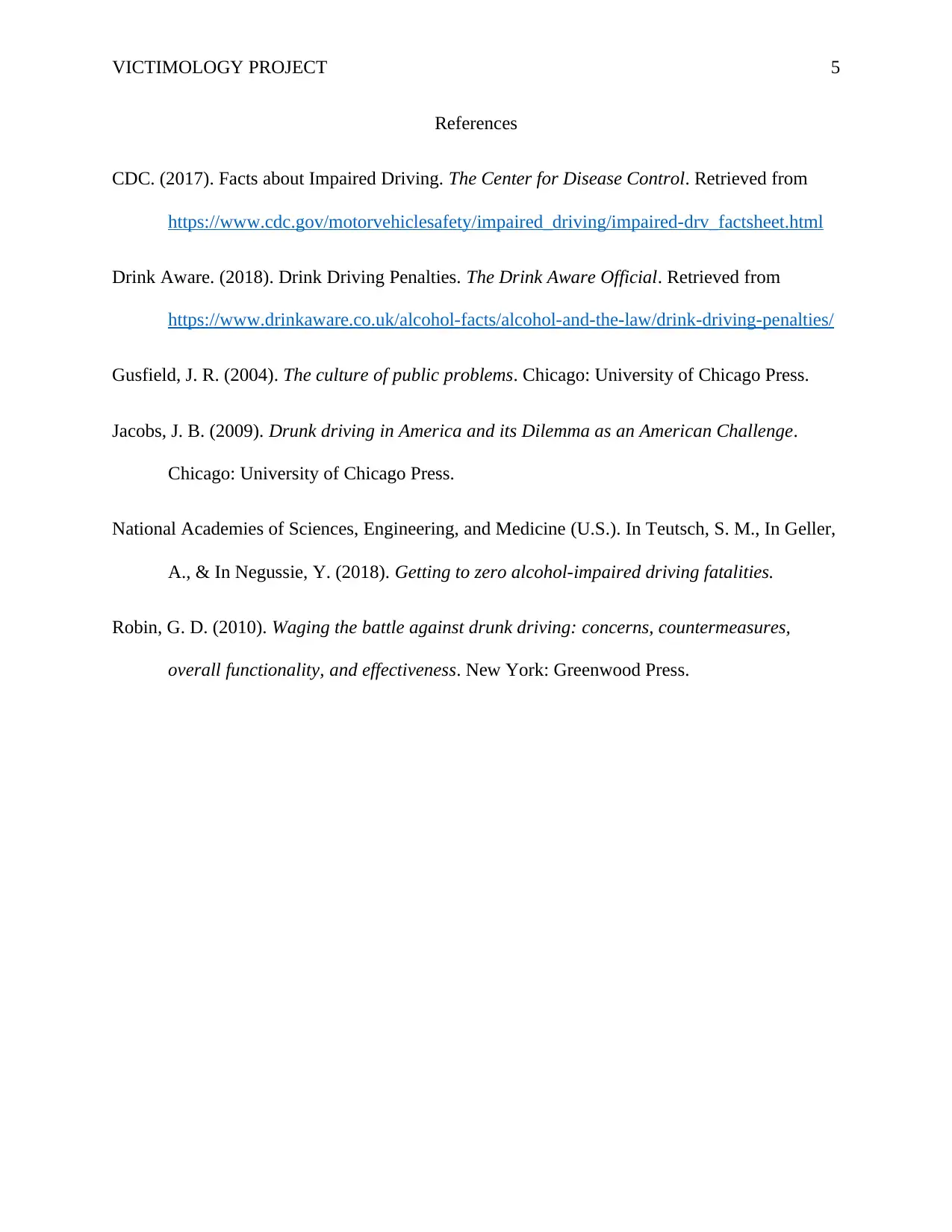
VICTIMOLOGY PROJECT 5
References
CDC. (2017). Facts about Impaired Driving. The Center for Disease Control. Retrieved from
https://www.cdc.gov/motorvehiclesafety/impaired_driving/impaired-drv_factsheet.html
Drink Aware. (2018). Drink Driving Penalties. The Drink Aware Official. Retrieved from
https://www.drinkaware.co.uk/alcohol-facts/alcohol-and-the-law/drink-driving-penalties/
Gusfield, J. R. (2004). The culture of public problems. Chicago: University of Chicago Press.
Jacobs, J. B. (2009). Drunk driving in America and its Dilemma as an American Challenge.
Chicago: University of Chicago Press.
National Academies of Sciences, Engineering, and Medicine (U.S.). In Teutsch, S. M., In Geller,
A., & In Negussie, Y. (2018). Getting to zero alcohol-impaired driving fatalities.
Robin, G. D. (2010). Waging the battle against drunk driving: concerns, countermeasures,
overall functionality, and effectiveness. New York: Greenwood Press.
References
CDC. (2017). Facts about Impaired Driving. The Center for Disease Control. Retrieved from
https://www.cdc.gov/motorvehiclesafety/impaired_driving/impaired-drv_factsheet.html
Drink Aware. (2018). Drink Driving Penalties. The Drink Aware Official. Retrieved from
https://www.drinkaware.co.uk/alcohol-facts/alcohol-and-the-law/drink-driving-penalties/
Gusfield, J. R. (2004). The culture of public problems. Chicago: University of Chicago Press.
Jacobs, J. B. (2009). Drunk driving in America and its Dilemma as an American Challenge.
Chicago: University of Chicago Press.
National Academies of Sciences, Engineering, and Medicine (U.S.). In Teutsch, S. M., In Geller,
A., & In Negussie, Y. (2018). Getting to zero alcohol-impaired driving fatalities.
Robin, G. D. (2010). Waging the battle against drunk driving: concerns, countermeasures,
overall functionality, and effectiveness. New York: Greenwood Press.
1 out of 5
Your All-in-One AI-Powered Toolkit for Academic Success.
+13062052269
info@desklib.com
Available 24*7 on WhatsApp / Email
![[object Object]](/_next/static/media/star-bottom.7253800d.svg)
Unlock your academic potential
© 2024 | Zucol Services PVT LTD | All rights reserved.